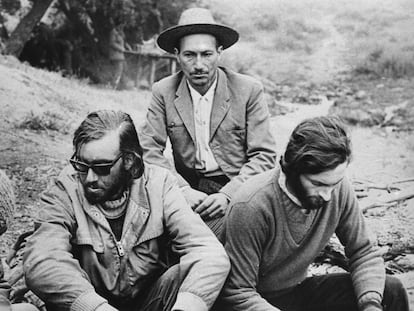‘It’s Chile’s Titanic, and yet no one remembers it’: The forgotten story of the 19th-century church fire that killed 2,000 women
Novelist Francisca Solar’s latest work is based on the ignored 1864 tragedy. ‘The New York Times’ headline at the time spoke of ‘a scene impossible to exaggerate... it cannot even be described’
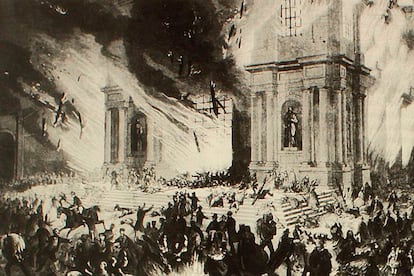

On December 8, 1863, nearly 10,000 candles and kerosene lamps illuminated the interior of the church of La Compañía de Jesús, in downtown Santiago de Chile, on the site of what today is the former National Congress. On the occasion of the celebration day of Our Lady of the Immaculate Conception, the church, one of the most-attended by the capital’s inhabitants in the 19th century, was adorned with a vast number of paper garlands. Some 3,000 parishioners came to La Compañía de Jesús, administered by the Jesuit priest Juan Bautista Ugarte, to commemorate the end of the month of Mary. Due to circumstances that were never determined, the building was engulfed by flames. In less than an hour, the fire took the lives of over 2,000 women, a toll that was reached after a house-by-house census was conducted to determine the scale of the human losses. “It’s Chile’s Titanic, and yet no one remembers it,” says journalist and writer Francisca Solar of a tragedy that should have more space not only in national history, she argues, but in universal history.
In her best-selling book El buzón de las impuras (The mailbox of the impure), Solar approaches the event from the perspective of the women who were burned to death in that church. Mostly aristocrats, they deposited letters containing their prayers and sins in a metal box that they called “the mailbox of the Virgin,” which the liberal press of the time baptized as “the mailbox of the impure” for being a kind of confessional. Surprisingly, it was one of the few objects that was spared from the flames and, after the fire, ecclesiastical and state authorities fought over it. It finally ended up in the hands of the mayor of Santiago. Although the contents never saw the light of day, their existence was enough to inspire Solar to write a historical novel.
In the reconstruction of the tragedy, the newspapers that circulated in Chile during that period, which are currently stored in the basement of the National Library, were key allies for the author’s research. Solar also drew on the extensive report published by The New York Times on its front page on January 18, 1864, which described the fire as “a scene impossible to exaggerate, it cannot even be described [...] It is absolutely impossible to convey in words any idea of the harrowing spectacle of Tuesday night.”
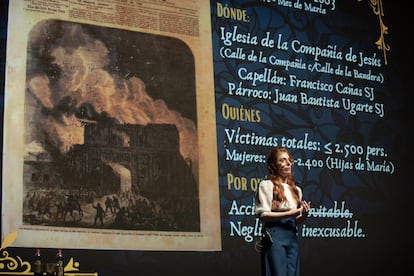
The writer tells EL PAIS that one of the reasons why the fire was forgotten was because it was a landmark involving women: “At the time, the death of a woman did not stop the system [...] The fact that 2,000 women died was like 2,000 chairs being burned,” she explains in a café in the residential municipality of Providencia. “In addition, everything private was always at the expense of the public. That means that, as terrible as it may sound, the deaths of 2,000 women in a church was treated as a domestic issue.”
On the origin of the fire, the journalist notes: “There is no doubt that it was an accident. It is very important to state that there was no malice.” She clarifies, however, that regardless of the fact that there was no intentionality, there was “a lot of negligence.” “The church had between 7,000 and 10,000 lights, which is a completely disproportionate and unusual number. It was the chronicle of a death foretold; a spark and the whole place was going to go up,” says Solar. The fact that the church doors were not double-hinged was also lethal. “The swing door protocol was not mandatory in Chile in 1863. Very few churches and hotels had adopted it, because it was a new and voluntary security measure. The church of La Compañía, in particular, was very old, poorly refurbished, and the entrances were very small with doors that only opened inwards. That was the responsibility of whoever managed the church and the Jesuits never updated the protocol. If all the entrances only opened to the inside, imagine a fire in which 3,000 people were trying to get out... They locked themselves in and all the accesses were quickly blocked.”
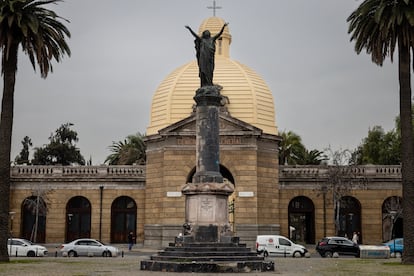
Among the factors that made it impossible to escape, there is one that especially “angers” Solar: when the fire began to spread, the priest Juan Bautista Ugarte and the apostolic nuncio (Vatican envoy) José Ignacio Eyzaguirre, who were presiding the mass, quickly fled through a door in the sacristy. “I don’t know the exact number of women who also managed to escape through there, it’s estimated at between 40 and 50,″ says the novelist, who notes that in several newspapers it was reported that “when Ugarte saw the women crossing the presbytery to reach the sacristy, he blocked the entrance.” This, says Solar, was with the aim of preventing women from stepping on floorspace that was considered holy, and that only priests could walk on.
When talking about the 1863 fire, the author points out, special emphasis was placed on the opulent dresses and crinoline blankets worn by the faithful, which were extremely flammable and also made it difficult to get to the exits. “It is inescapable that the apparel of the time was an obstacle. We know this, moreover, because there were women who saved themselves by taking their clothes off [...] However, to me the fact that a priest closed the door seems much more serious. How many more women could have been saved?”
After the tragedy, the writer says, the mayor of Santiago, Francisco Bascuñán Guerrero, who lost his sister Mercedes in the fire, ordered that all places where many people congregated be fitted with double hinges. The first fire brigade in the Chilean capital was also created.
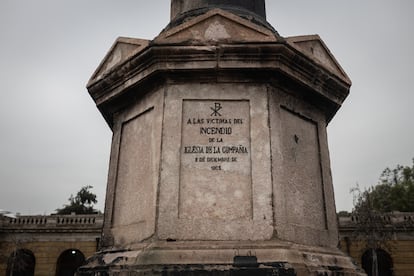
“Justice must be done; not only must a milestone in Chilean history that few know about be made visible, this is also a historical vindication. I am interested in telling the story of the La Compañía fire from the perspective of women because I need there to be at least a gesture of justice towards them. A phrase from Lastesis is obvious: ‘And the fault wasn’t mine, not where I was, not how I dressed,’ says Solar in reference to the poem A rapist in your path, created by the feminist collective during the demonstrations against gender violence held in Chile in 2019.
Of the 2,000 women who died in the fire, only seven were identified. The authorities at the time decided to bury them in a common grave in the General Cemetery of Santiago. The most widely accepted hypothesis, according to researchers, is that this site is currently located in the Plaza de la Paz. To honor them, half a century after the tragedy, firefighters moved the statue of La Dolorosa, which was originally built on the ashes of the church, to the same location.
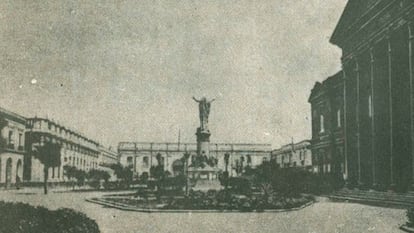
Sign up for our weekly newsletter to get more English-language news coverage from EL PAÍS USA Edition
Tu suscripción se está usando en otro dispositivo
¿Quieres añadir otro usuario a tu suscripción?
Si continúas leyendo en este dispositivo, no se podrá leer en el otro.
FlechaTu suscripción se está usando en otro dispositivo y solo puedes acceder a EL PAÍS desde un dispositivo a la vez.
Si quieres compartir tu cuenta, cambia tu suscripción a la modalidad Premium, así podrás añadir otro usuario. Cada uno accederá con su propia cuenta de email, lo que os permitirá personalizar vuestra experiencia en EL PAÍS.
¿Tienes una suscripción de empresa? Accede aquí para contratar más cuentas.
En el caso de no saber quién está usando tu cuenta, te recomendamos cambiar tu contraseña aquí.
Si decides continuar compartiendo tu cuenta, este mensaje se mostrará en tu dispositivo y en el de la otra persona que está usando tu cuenta de forma indefinida, afectando a tu experiencia de lectura. Puedes consultar aquí los términos y condiciones de la suscripción digital.
More information
Archived In
Últimas noticias
Welcome to the post-religion era: The idea of Christianity as the absolute truth has become obsolete
‘I thought you would like it’: The risky sexual practice popularized by TV shows and TikTok
The digitalization of tourism: ‘They promise experiences and gave us the worst possible one’
Mexican peso defies uncertainty with forecasts of a new period of stability in 2026
Most viewed
- Sinaloa Cartel war is taking its toll on Los Chapitos
- Reinhard Genzel, Nobel laureate in physics: ‘One-minute videos will never give you the truth’
- Oona Chaplin: ‘I told James Cameron that I was living in a treehouse and starting a permaculture project with a friend’
- Why the price of coffee has skyrocketed: from Brazilian plantations to specialty coffee houses
- Silver prices are going crazy: This is what’s fueling the rally

